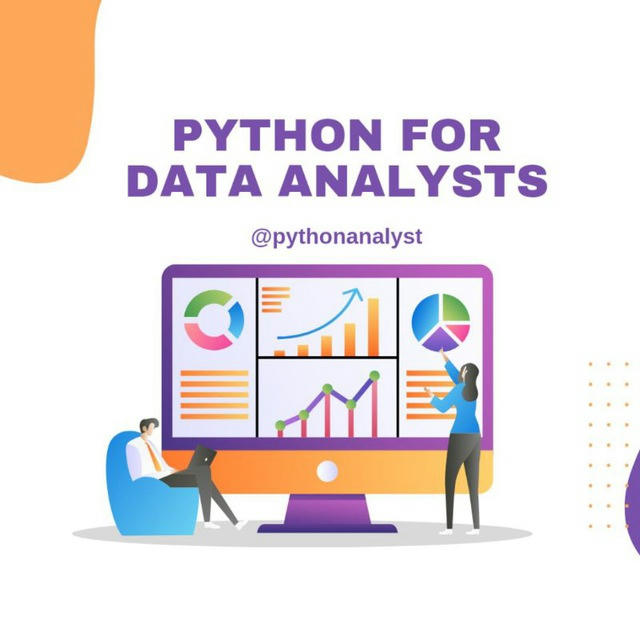
Python for Data Analysts
Python for Data Analysts Admin: @guideishere12
Mostrar más24 283
Suscriptores
+13724 horas
+6597 días
+2 98330 días
- Suscriptores
- Cobertura postal
- ER - ratio de compromiso
Carga de datos en curso...
Tasa de crecimiento de suscriptores
Carga de datos en curso...
These 6 videos will help you to get the product knowledge and case study solving skill
👇👇
https://t.me/caseinterviewscracked/18
𝐈𝐦𝐩𝐨𝐫𝐭𝐢𝐧𝐠 𝐍𝐞𝐜𝐞𝐬𝐬𝐚𝐫𝐲 𝐋𝐢𝐛𝐫𝐚𝐫𝐢𝐞𝐬:
import pandas as pd
import numpy as np
import matplotlib.pyplot as plt
import seaborn as sns
𝐋𝐨𝐚𝐝𝐢𝐧𝐠 𝐭𝐡𝐞 𝐃𝐚𝐭𝐚𝐬𝐞𝐭:
df = pd.read_csv('your_dataset.csv')
𝐈𝐧𝐢𝐭𝐢𝐚𝐥 𝐃𝐚𝐭𝐚 𝐈𝐧𝐬𝐩𝐞𝐜𝐭𝐢𝐨𝐧:
1- View the first few rows:
df.head()
2- Summary of the dataset:
df.info()
3- Statistical summary:
df.describe()
𝐇𝐚𝐧𝐝𝐥𝐢𝐧𝐠 𝐌𝐢𝐬𝐬𝐢𝐧𝐠 𝐕𝐚𝐥𝐮𝐞𝐬:
1- Identify missing values:
df.isnull().sum()
2- Visualize missing values:
sns.heatmap(df.isnull(), cbar=False, cmap='viridis')
plt.show()
𝐃𝐚𝐭𝐚 𝐕𝐢𝐬𝐮𝐚𝐥𝐢𝐳𝐚𝐭𝐢𝐨𝐧:
1- Histograms:
df.hist(bins=30, figsize=(20, 15))
plt.show()
2 - Box plots:
plt.figure(figsize=(10, 6))
sns.boxplot(data=df)
plt.xticks(rotation=90)
plt.show()
3- Pair plots:
sns.pairplot(df)
plt.show()
4- Correlation matrix and heatmap:
correlation_matrix = df.corr()
plt.figure(figsize=(12, 8))
sns.heatmap(correlation_matrix, annot=True, cmap='coolwarm')
plt.show()
𝐂𝐚𝐭𝐞𝐠𝐨𝐫𝐢𝐜𝐚𝐥 𝐃𝐚𝐭𝐚 𝐀𝐧𝐚𝐥𝐲𝐬𝐢𝐬:
Count plots for categorical features:
plt.figure(figsize=(10, 6))
sns.countplot(x='categorical_column', data=df)
plt.show()
👍 29❤ 8
Exploratory Data Analysis (EDA) in Python involves a variety of techniques and tools to summarize, visualize, and understand the structure of a dataset. Here are some common EDA techniques using Python, along with relevant libraries:
𝐒𝐭𝐫𝐢𝐧𝐠 𝐌𝐚𝐧𝐢𝐩𝐮𝐥𝐚𝐭𝐢𝐨𝐧 𝐢𝐧 𝐏𝐲𝐭𝐡𝐨𝐧:
Strings in Python are immutable sequences of characters.
𝟏- 𝐥𝐞𝐧(): 𝐑𝐞𝐭𝐮𝐫𝐧𝐬 𝐭𝐡𝐞 𝐥𝐞𝐧𝐠𝐭𝐡 𝐨𝐟 𝐭𝐡𝐞 𝐬𝐭𝐫𝐢𝐧𝐠.
my_string = "Hello"
length = len(my_string) # length will be 5
𝟐- 𝐬𝐭𝐫(): 𝐂𝐨𝐧𝐯𝐞𝐫𝐭𝐬 𝐧𝐨𝐧-𝐬𝐭𝐫𝐢𝐧𝐠 𝐝𝐚𝐭𝐚 𝐭𝐲𝐩𝐞𝐬 𝐢𝐧𝐭𝐨 𝐬𝐭𝐫𝐢𝐧𝐠𝐬.
num = 123
str_num = str(num) # str_num will be "123"
𝟑- 𝐥𝐨𝐰𝐞𝐫() 𝐚𝐧𝐝 𝐮𝐩𝐩𝐞𝐫(): 𝐂𝐨𝐧𝐯𝐞𝐫𝐭 𝐚 𝐬𝐭𝐫𝐢𝐧𝐠 𝐭𝐨 𝐥𝐨𝐰𝐞𝐫𝐜𝐚𝐬𝐞 𝐨𝐫 𝐮𝐩𝐩𝐞𝐫𝐜𝐚𝐬𝐞.
my_string = "Hello"
lower_case = my_string.lower() # lower_case will be "hello"
upper_case = my_string.upper() # upper_case will be "HELLO"
𝟒- 𝐬𝐭𝐫𝐢𝐩(): 𝐑𝐞𝐦𝐨𝐯𝐞𝐬 𝐥𝐞𝐚𝐝𝐢𝐧𝐠 𝐚𝐧𝐝 𝐭𝐫𝐚𝐢𝐥𝐢𝐧𝐠 𝐰𝐡𝐢𝐭𝐞𝐬𝐩𝐚𝐜𝐞 𝐟𝐫𝐨𝐦 𝐚 𝐬𝐭𝐫𝐢𝐧𝐠.
my_string = " Hello "
stripped_string = my_string.strip() # stripped_string will be "Hello"
𝟓- 𝐬𝐩𝐥𝐢𝐭(): 𝐒𝐩𝐥𝐢𝐭𝐬 𝐚 𝐬𝐭𝐫𝐢𝐧𝐠 𝐢𝐧𝐭𝐨 𝐚 𝐥𝐢𝐬𝐭 𝐨𝐟 𝐬𝐮𝐛𝐬𝐭𝐫𝐢𝐧𝐠𝐬 𝐛𝐚𝐬𝐞𝐝 𝐨𝐧 𝐚 𝐝𝐞𝐥𝐢𝐦𝐢𝐭𝐞𝐫.
my_string = "apple,banana,orange"
fruits = my_string.split(",") # fruits will be ["apple", "banana", "orange"]
𝟔- 𝐣𝐨𝐢𝐧(): 𝐉𝐨𝐢𝐧𝐬 𝐭𝐡𝐞 𝐞𝐥𝐞𝐦𝐞𝐧𝐭𝐬 𝐨𝐟 𝐚 𝐥𝐢𝐬𝐭 𝐢𝐧𝐭𝐨 𝐚 𝐬𝐢𝐧𝐠𝐥𝐞 𝐬𝐭𝐫𝐢𝐧𝐠 𝐮𝐬𝐢𝐧𝐠 𝐚 𝐬𝐩𝐞𝐜𝐢𝐟𝐢𝐞𝐝 𝐬𝐞𝐩𝐚𝐫𝐚𝐭𝐨𝐫.
fruits = ["apple", "banana", "orange"]
my_string = ",".join(fruits) # my_string will be "apple,banana,orange"
𝟕- 𝐟𝐢𝐧𝐝() 𝐚𝐧𝐝 𝐢𝐧𝐝𝐞𝐱(): 𝐒𝐞𝐚𝐫𝐜𝐡 𝐟𝐨𝐫 𝐚 𝐬𝐮𝐛𝐬𝐭𝐫𝐢𝐧𝐠 𝐰𝐢𝐭𝐡𝐢𝐧 𝐚 𝐬𝐭𝐫𝐢𝐧𝐠 𝐚𝐧𝐝 𝐫𝐞𝐭𝐮𝐫𝐧 𝐢𝐭𝐬 𝐢𝐧𝐝𝐞𝐱.
my_string = "Hello, world!"
index1 = my_string.find("world") # index1 will be 7
index2 = my_string.index("world") # index2 will also be 7
𝟖- 𝐫𝐞𝐩𝐥𝐚𝐜𝐞(): 𝐑𝐞𝐩𝐥𝐚𝐜𝐞𝐬 𝐨𝐜𝐜𝐮𝐫𝐫𝐞𝐧𝐜𝐞𝐬 𝐨𝐟 𝐚 𝐬𝐮𝐛𝐬𝐭𝐫𝐢𝐧𝐠 𝐰𝐢𝐭𝐡 𝐚𝐧𝐨𝐭𝐡𝐞𝐫 𝐬𝐮𝐛𝐬𝐭𝐫𝐢𝐧𝐠.
my_string = "Hello, world!"
new_string = my_string.replace("world", "Python") # new_string will be "Hello, Python!"
𝟗- 𝐬𝐭𝐚𝐫𝐭𝐬𝐰𝐢𝐭𝐡() 𝐚𝐧𝐝 𝐞𝐧𝐝𝐬𝐰𝐢𝐭𝐡(): 𝐂𝐡𝐞𝐜𝐤𝐬 𝐢𝐟 𝐚 𝐬𝐭𝐫𝐢𝐧𝐠 𝐬𝐭𝐚𝐫𝐭𝐬 𝐨𝐫 𝐞𝐧𝐝𝐬 𝐰𝐢𝐭𝐡 𝐚 𝐬𝐩𝐞𝐜𝐢𝐟𝐢𝐞𝐝 𝐬𝐮𝐛𝐬𝐭𝐫𝐢𝐧𝐠.
my_string = "Hello, world!"
starts_with_hello = my_string.startswith("Hello") # True
ends_with_world = my_string.endswith("world") # False
𝟏𝟎- 𝐜𝐨𝐮𝐧𝐭(): 𝐂𝐨𝐮𝐧𝐭𝐬 𝐭𝐡𝐞 𝐨𝐜𝐜𝐮𝐫𝐫𝐞𝐧𝐜𝐞𝐬 𝐨𝐟 𝐚 𝐬𝐮𝐛𝐬𝐭𝐫𝐢𝐧𝐠 𝐢𝐧 𝐚 𝐬𝐭𝐫𝐢𝐧𝐠.
my_string = "apple, banana, orange, banana"
count = my_string.count("banana") # count will be 2
Python Complete Notion Notes with 5 Practical Projects
👇👇
https://topmate.io/analyst/871454
Hope you'll like it
Like this post if you need more resources like this 👍❤️
👍 31❤ 4👏 2
Python Interview Questions for Data/Business Analysts:
Question 1:
Given a dataset in a CSV file, how would you read it into a Pandas DataFrame? And how would you handle missing values?
Question 2:
Describe the difference between a list, a tuple, and a dictionary in Python. Provide an example for each.
Question 3:
Imagine you are provided with two datasets, 'sales_data' and 'product_data', both in the form of Pandas DataFrames. How would you merge these datasets on a common column named 'ProductID'?
Question 4:
How would you handle duplicate rows in a Pandas DataFrame? Write a Python code snippet to demonstrate.
Question 5:
Describe the difference between '.iloc[] and '.loc[]' in the context of Pandas.
Question 6:
In Python's Matplotlib library, how would you plot a line chart to visualize monthly sales? Assume you have a list of months and a list of corresponding sales numbers.
Question 7:
How would you use Python to connect to a SQL database and fetch data into a Pandas DataFrame?
Question 8:
Explain the concept of list comprehensions in Python. Can you provide an example where it's useful for data analysis?
Question 9:
How would you reshape a long-format DataFrame to a wide format using Pandas? Explain with an example.
Question 10:
What are lambda functions in Python? How are they beneficial in data wrangling tasks?
Question 11:
Describe a scenario where you would use the 'groupby()' method in Pandas. How would you aggregate data after grouping?
Question 12:
You are provided with a Pandas DataFrame that contains a column with date strings. How would you convert this column to a datetime format? Additionally, how would you extract the month and year from these datetime objects?
Question 13:
Explain the purpose of the 'pivot_table' method in Pandas and describe a business scenario where it might be useful.
Question 14:
How would you handle large datasets that don't fit into memory? Are you familiar with Dask or any similar libraries?
Python Interview Q&A: https://topmate.io/coding/898340
Like for more ❤️
ENJOY LEARNING 👍👍
👍 12❤ 11🥰 2
Python Programming Interview Questions for Entry Level Data Analyst
1. What is Python, and why is it popular in data analysis?
2. Differentiate between Python 2 and Python 3.
3. Explain the importance of libraries like NumPy and Pandas in data analysis.
4. How do you read and write data from/to files using Python?
5. Discuss the role of Matplotlib and Seaborn in data visualization with Python.
6. What are list comprehensions, and how do you use them in Python?
7. Explain the concept of object-oriented programming (OOP) in Python.
8. Discuss the significance of libraries like SciPy and Scikit-learn in data analysis.
9. How do you handle missing or NaN values in a DataFrame using Pandas?
10. Explain the difference between loc and iloc in Pandas DataFrame indexing.
11. Discuss the purpose and usage of lambda functions in Python.
12. What are Python decorators, and how do they work?
13. How do you handle categorical data in Python using the Pandas library?
14. Explain the concept of data normalization and its importance in data preprocessing.
15. Discuss the role of regular expressions (regex) in data cleaning with Python.
16. What are Python virtual environments, and why are they useful?
17. How do you handle outliers in a dataset using Python?
18. Explain the usage of the map and filter functions in Python.
19. Discuss the concept of recursion in Python programming.
20. How do you perform data analysis and visualization using Jupyter Notebooks?
Python Interview Q&A: https://topmate.io/coding/898340
Like for more ❤️
ENJOY LEARNING 👍👍
👍 23❤ 7
⌨️ Benefits of learning Python Programming
1. Web Development: Python frameworks like Django and Flask are popular for building dynamic websites and web applications.
2. Data Analysis: Python has powerful libraries like Pandas and NumPy for data manipulation and analysis, making it widely used in data science and analytic.
3. Machine Learning: Python's libraries such as TensorFlow, Keras, and Scikit-learn are extensively used for implementing machine learning algorithms and building predictive models.
4. Artificial Intelligence: Python is commonly used in AI development due to its simplicity and extensive libraries for tasks like natural language processing, image recognition, and neural network implementation.
5. Cybersecurity: Python is utilized for tasks such as penetration testing, network scanning, and creating security tools due to its versatility and ease of use.
6. Game Development: Python, along with libraries like Pygame, is used for developing games, prototyping game mechanics, and creating game scripts.
7. Automation: Python's simplicity and versatility make it ideal for automating repetitive tasks, such as scripting, data scraping, and process automation.
👍 22❤ 3
Programming and Problem Solving with Python
Ashok Namdev Kamthane, 2018
Programming and Problem Solving with Python.pdf10.42 MB
👍 17

 Network:
Network: